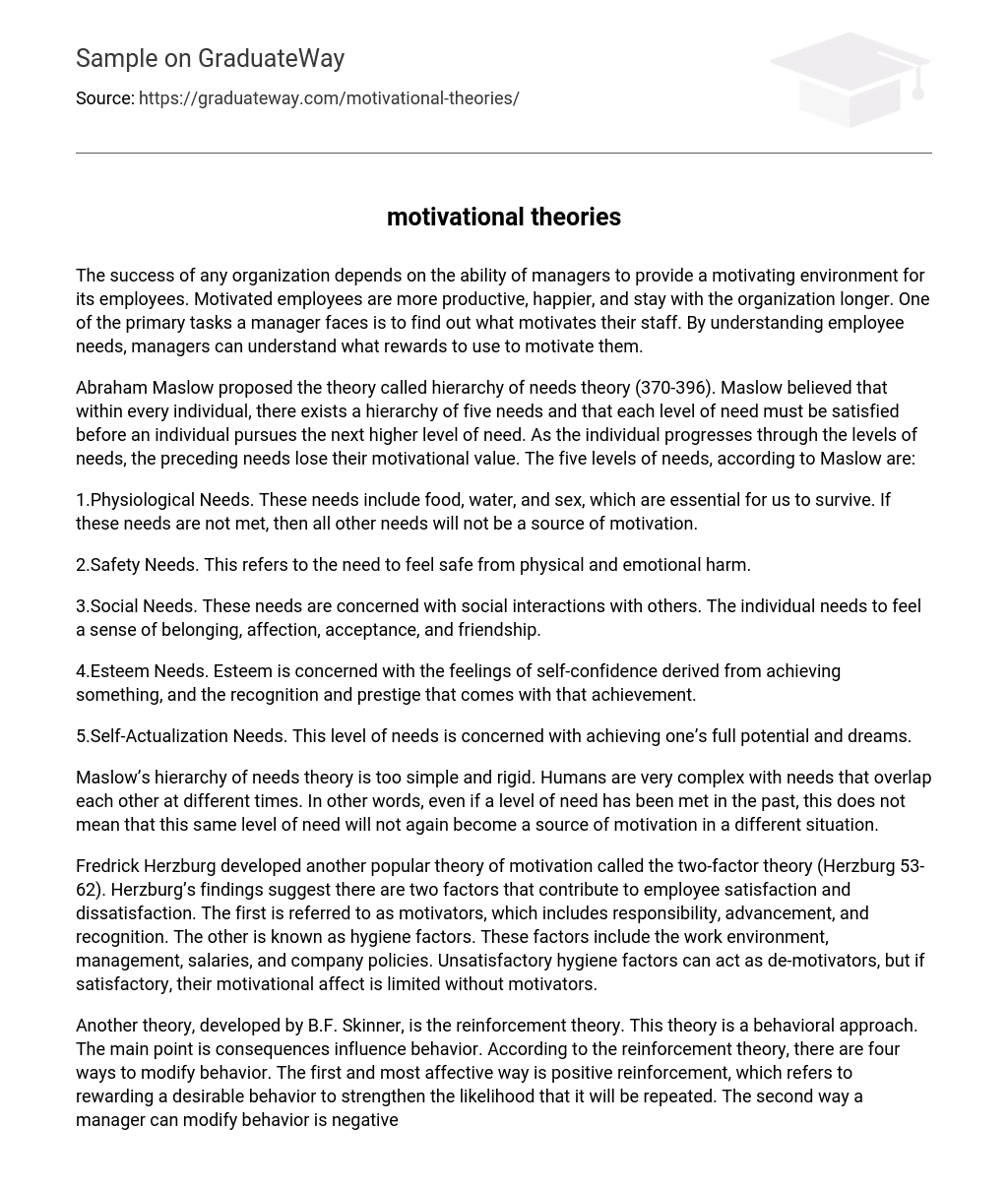Managers play a crucial role in an organization’s success by creating a motivating environment for employees. Engaged employees are not only more productive but also happier and more likely to stay with the company. It is essential for managers to identify the factors that inspire motivation among staff members and understand their needs. By doing so, they can determine appropriate rewards to enhance employee motivation.
According to Abraham Maslow, the hierarchy of needs theory (370-396) states that individuals have a hierarchical structure consisting of five needs. Each level must be satisfied before progressing to the next higher level. As an individual fulfills needs at one level, the significance and incentive for preceding needs decrease. Maslow’s five levels of needs are as follows:
Basic needs, including food, water, and sex, are crucial for our survival. If these needs remain unmet, other motivations lose their effectiveness.
The need for safety, which encompasses both physical and emotional security, is the second level of needs.
3. Social Needs: These encompass the individual’s requirement for social interaction and connections. They include the need for a sense of belonging, affection, acceptance, and friendship.
4. Esteem needs refer to the satisfaction one derives from achieving something and the prestige and recognition that accompany that achievement.
Self-actualization needs, the fifth level of needs, focus on the attainment of one’s full potential and aspirations.
According to Maslow’s hierarchy of needs theory, it is argued that it is oversimplified and inflexible. Humans are intricate beings with overlapping needs that vary depending on the circumstances. This implies that even if a certain need has been fulfilled previously, it can still serve as a motivating factor in a different scenario.
Frederick Herzburg introduced the two-factor theory, also known as the motivator-hygiene theory (Herzburg 53-62). According to Herzburg’s research, there are two elements that impact employee contentment and discontent. The first element, known as motivators, encompasses responsibilities, opportunities for advancement, and recognition. The second element, referred to as hygiene factors, includes the work environment, management, salaries, and company policies. Inadequate hygiene factors can demotivate employees, but their motivational impact is limited even if they are satisfactory without the presence of motivators.
The reinforcement theory, created by B.F. Skinner, is a behavioral approach that focuses on the impact of consequences on behavior. It outlines four methods for altering behavior: positive reinforcement, negative reinforcement, punishment, and absence of reinforcement.
Victor Vroom introduced the expectancy theory of motivation, which focuses on how individuals internally evaluate their willingness to exert effort towards a specific goal. According to Vroom, three crucial factors are vital in determining motivation. The first factor is “valence,” which represents an individual’s desire to achieve a goal or fulfill a need. The second factor is “instrumentality,” which relates to the belief that if someone performs at a certain level, they can expect a favorable outcome. The third factor is “expectancy,” which involves an individual’s belief about the connection between effort and performance. If someone puts in significant effort, they can anticipate positive results.
The motivation of individuals is influenced by how they perceive the desirability and feasibility of a goal. This is just a sample of motivational theories; there are numerous others. Irrespective of the theory adopted, engaging tasks and fair remuneration are crucial for enhancing motivation. Strategies like expanding job responsibilities, enriching job content, offering promotions, providing financial and non-financial rewards should be taken into account. Understanding the specific factors that drive employee motivation is fundamental in developing a tailor-made motivation program.
Works cited
Herzberg, Fredrick. “One More time: How Do You Motivate Employees?” Harvard Business Review Jan.-Feb.1968: 53-62
Maslow, Abraham F. “A Theory of Human Motivation.” Psychological Review 50 (1943): 370-396
Skinner, B.F. Science and Human Behavior. New York: Macmillan, 1953
Vroom, Victor H. Work and Motivation. New York: Wiley, 1964
References
Herzberg, F. (1968). One More time: How Do You Motivate Employees? Harvard Business Review Jan.-Feb., 53-62.
Maslow, A.F. (1943). A Theory of Human Motivation. Psychological Review, 50(4), 370-396.
Skinner, B.F. (1953). Science and Human Behavior. New York: Macmillan.
Vroom, V.H. (1964). Work and Motivation. New York: Wiley.





